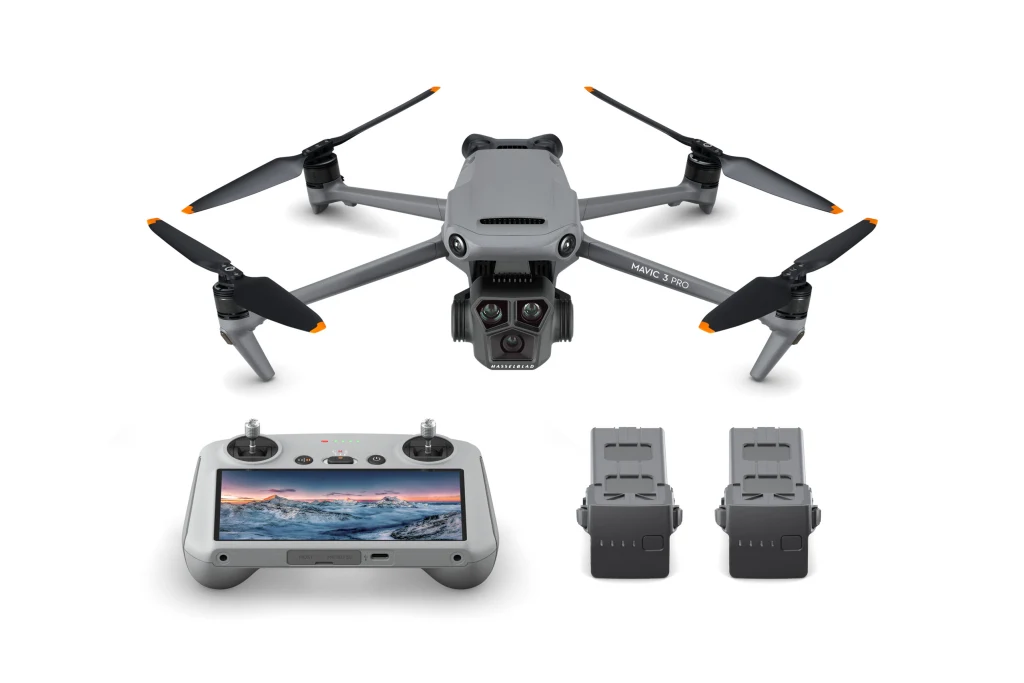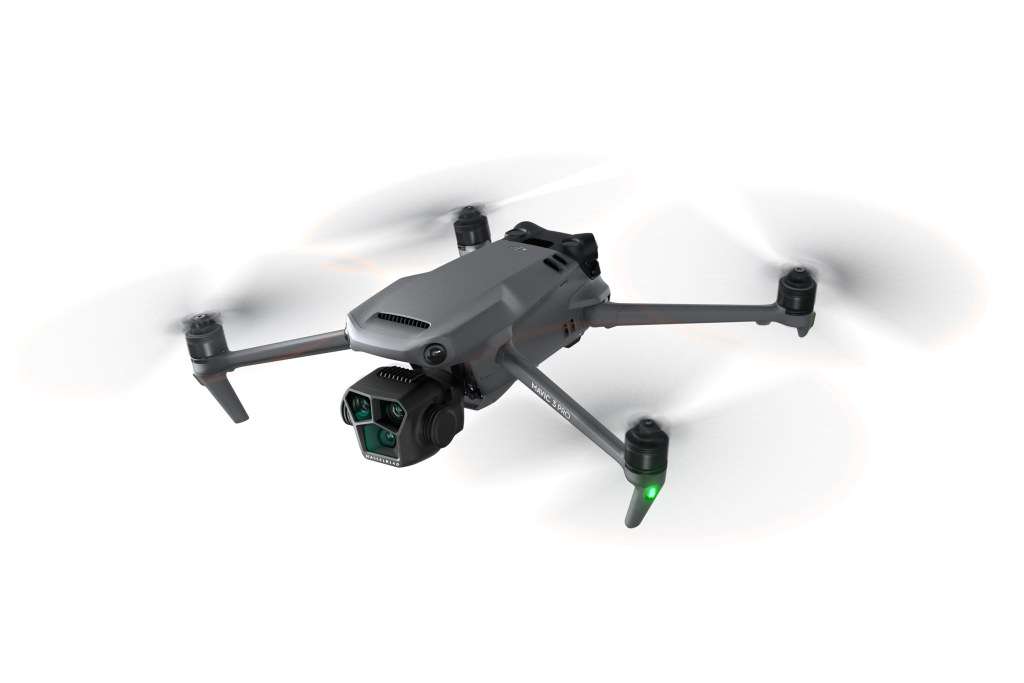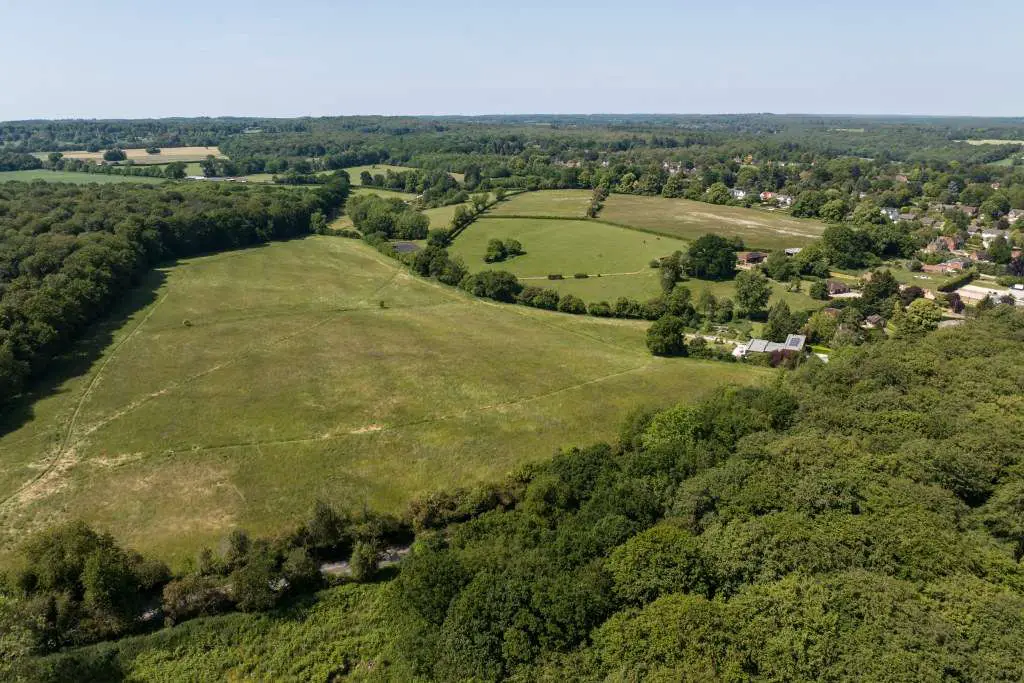DJI’s Mavic 3 Pro expands on the Mavic 3’s two cameras to provide an even more flexible, high-end drone. So we pick up the joystick to see if it’s the greatest drone with a camera.
A quick look at the DJI Mavic 3 Pro
- Drone with three integrated cameras
- $2,199 / £1,879 with DJI RC controller
- $2,999 / £2,549 Fly More Combo with DJI RC controller
- $3,628 / £3,169 Fly More Combo with DJI RC Pro controller
- 20Mp main camera with Four-Thirds CMOS sensor
- 24mm equivalent f/2.8 main lens
- Up to 43 minutes of flight time per battery
- Max video resolution of 5.1K (5120 x 2700) at 24/25/30/48/50fps
- 958g take-off weight

DJI Mavic 3 Pro
The 3 Pro has all of the same functionality as the Mavic 3, but instead of two cameras, it has three attached through a mechanically stabilized gimbal. The Mavic 3 Pro’s primary camera, like the Mavic 3 and Mavic 3 Classic, was created in collaboration with Hasselblad and has a 20MP Four Thirds sensor fronted by a 24mm equivalent lens. A 48MP telephoto camera with a 70mm equivalent focal length and a 1/1.3-inch type CMOS sensor joins this, as does a 12MP 166mm equivalent camera with a 1/2-inch type CMOS sensor.

L2D-20c · f/2.8 · 1/1000s · 12.29mm · ISO100
DJI Mavic 3 Pro – What you need to know:
Triple camera
The Mavic 3 Pro is the first consumer drone with three cameras fitted on a gimbal for stability.
Folding legs
The legs of the Mavic 3 Pro like the other Mavic 3 drones, fold in towards the fuselage to make transporting it between flights easier.
Object avoidance
To avoid collisions, omnidirectional sensors identify objects in the flight path.
Read also: DJI Mini 3 Review
Storage
A microSD card slot and 8GB of internal storage are provided.
Regulations
To fly the Mavic 3 Pro closer than 150m from residential, commercial, industrial, or recreational zones in the United Kingdom, an A2 Certificate of Competency is required. It must not be flown closer to uninvolved individuals than 50m horizontally.
While the primary camera has a variable aperture that can be set between f/2.8 and f/11, the other two cameras have fixed apertures of f/2.8 for the 70mm and f/3.4 for the 166mm. Fixed apertures are prevalent in consumer drones, although they need the use of a collection of neutral density filters for recording video.

L2D-20c · f/2.8 · 1/1250s · 12.29mm · ISO100
In terms of video, the Mavic 3 Pro’s primary camera can shoot in 5.1K (5120 x 2700) quality at 24/25/30/48/50fps in MP4 or MOV (MPEG-4 AVC/H.264, HEVC/H.265) format, with bit rates up to 200Mbps. When switching to the other cameras, the maximum resolution reduces to 4K (3840 x 2160) at up to 60fps and 160Mbps. In slow-motion mode, the Hasselblad camera can capture DCI 4K (4096 x 2160) or 4K (3840 x 2160) film at up to 120fps, and Full HD (1920 x1080) at up to 200fps.
All three cameras record 8-bit 4:2:0 (H.264/H.265) color by default, however, the primary and 70mm cameras may alternatively record in D-Log, D-Log M, or HLG-enabled 10-bit 4:2:0 color.
DJI Mavic 3 Pro Controllers
Surprisingly, DJI does not sell the Mavic 3 Pro as a standalone drone. Instead, it can only be purchased with a controller, of which there are two options: the DJI RC or the DJI RC Pro. The DJI RC Pro is larger than the RC, however, while having a brighter screen (1000 nits versus 700), it has the same size and resolution (5.5 inches and 1080p). That added brightness is good, but I’ve never had an issue with the RC.

The DJI RC is also much lighter (390g vs. 680g), has a 1-hour longer battery life (4 hours), and lowers the kit price considerably. I’d go with the DJI RC over the RC Pro.
DJI Mavic 3 Pro Flying Time
Because the Mavic 3 Pro weighs 63g more than the Mavic 3, it’s no wonder that DJI claims a reduced maximum flying duration of 43 minutes (down from 46 minutes) on a single battery charge. Meanwhile, the maximum hover duration has been reduced from 40 to 37 minutes. In real-world use, which included hovering, photographing, and filming, I achieved roughly 31 minutes of flight duration on a single battery charge.

While that is a reasonable flying time, I would still go for at least one extra battery (£179) or the Fly More Combo. That includes the 3 Pro, two extra batteries, a three-battery charging hub, spare propellers, a backpack, and a set of four ND filters. The DJI RC costs £2,549 and the DJI RC Pro costs £3,169.
DJI Mavic 3 Pro Performance
The DJI 3 Pro, like all of DJI’s current imaging drones, is very easy to operate, and its gimbal does an excellent job of stabilizing the cameras so that even when the drone is buffeted by a blast of wind, the footage remains smooth. The omnidirectional object avoidance system is similarly dependable when flying manually rather than automatically.

L2D-20c · f/5.6 · 1/400s · 12.29mm · ISO100
The primary camera produces outstanding results, but the two telephoto cameras are also extremely good, albeit with a more limited range of video options. The degree of detail seen in the 12MP photographs from the 166mm camera is unavoidably reduced, but it’s still useful if you can’t fly closer to your subject.
DJI Mavic 3 Pro Verdict

L2D-20c · f/2.8 · 1/1600s · 12.29mm · ISO120
The DJI 3 Pro expands on the Mavic 3 by adding a third camera and producing excellent results from all of them. This makes the Mavic 3 Pro more flexible, but it also raises the price by roughly £500 when compared to the Mavic 3 Classic, which has the same function set but just the 24mm Hasselblad camera with the Four Thirds type sensor.
Check also: DJI Mini 3 vs DJI Mini 2
The choice ultimately boils down to how frequently you’d feel the need to utilize a longer lens rather than fly closer to your topic. Most photographers hoping to capture aerial landscape pictures will likely be satisfied with the Classic.
DJI Mavic 3 Pro Cine
DJI also sells a Cine Mavic 3 Pro as part of a Premium Combo bundle. The Mavic 3 Pro Cine is very identical to the standard model, however, it can record Apple ProRes 422 HQ/422/4222 LT footage with either of the cameras. This is made possible by an embedded 1TB SSD, which increases the weight of the drone to 963g and raises the price to £4,109 with all of the standard Fly More Combo extras.



